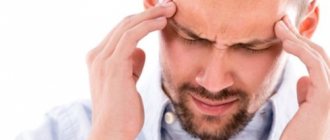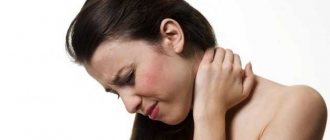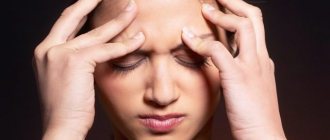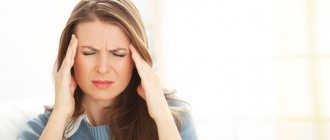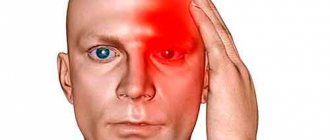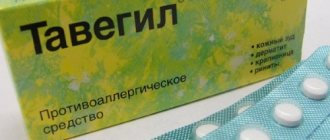Every person experiences a headache from time to time, because it is a common symptom of many diseases.
The factors that provoke this ailment can be very diverse, as well as its manifestations. The pain syndrome is usually localized in the occipital, temporal or frontal parts, but quite often patients complain that the left side of the head hurts.
When pain occurs on the left side of the head, most people rush to take a painkiller or try to endure a tense state without thinking about the cause of the ailment.
Meanwhile, attacks that periodically appear on the left side of the head can become chronic and cause severe discomfort, and painkillers will lose their healing properties. Therefore, if pain attacks occur regularly, it is necessary to contact a specialist who will conduct a diagnosis and establish the true cause of this ailment.
Migraine
Most often in such cases, a diagnosis of migraine is made. This pain affects the left side of the head, the left eye and ear, and sometimes the forehead. When the painful sensation worsens, nausea, vomiting, trembling in the body, increased sweating may appear, and sharp flashes of light and noise can be very difficult to tolerate. During an intensifying migraine attack, even the olfactory receptors may be disrupted. Hallucinations of smell appear, for example, a person can smell a rotten egg and so on. Everything that is seen and felt during an exacerbation and pain can last for several hours, and in some cases for several days. The left side of the head, the left side of the face, the ear and the eye hurt excruciatingly. When the attacks end, severe fatigue and drowsiness sets in, and increased fatigue remains.
Throbbing and pain on the left side of the head, what could this mean?
Most people do not consider headaches to be an abnormality or a serious illness. For this reason, they do not consult a doctor. In cases where medical assistance is ignored, periodic attacks turn into repeated ones.
They disable the normal functioning of the entire body and prevent it from working normally. Overstrain of brain vessels leads to weakening of the walls and their rupture, which in turn leads to strokes, paralysis and even death.
You can't put your life in danger.
Local pain in the left hemisphere of the head is considered by many to be a strange phenomenon. This begs the question. Why does only one part of my head hurt? What load does it carry?
Don't ignore the warning signs!
The left hemisphere of the human brain is responsible for:
- logical thinking;
- language abilities;
- analytical thinking;
- sequential processing of information;
- mathematical abilities;
- exercises control over the movements of the right half of the body.
Therefore, experts largely associate throbbing pain in the left side of the head with a person’s professional sphere of activity. This is sedentary and sedentary office work, requiring continuous use of analytical and logical thinking.
The process of constantly working with computer equipment can lead to constant seizures, which makes it difficult to perform it at the proper level. Hard physical labor that requires special muscle tension (especially the right part of the body, for which the left hemisphere is responsible).
For example, working on a conveyor belt with small parts can contribute to the onset of an attack after just a few minutes.
Depending on the nature of the pain, it can be:
- pulsating,
- shooting,
- burning,
- aching,
- pulling,
- pressing.
By localization it is divided into:
- frontal,
- temporal,
- parietal,
- behind the ear,
- occipital
Sharp pain can be transmitted to the eyes and occur as a result of bending and turning the upper body and head. There is significant memory impairment and problems with motor coordination.
Sometimes leads to noise and nausea. In any case, no matter what the nature and location of the suffering, it is necessary to respond to it.
The consequences of neglect can be unpredictable, sometimes even fatal.
Etiology:
- Constant discomfort, inability to think clearly, disrupted daily routine becomes a problem for many. Even very patient people resort to using medications. But painkillers only provide relief for a short period of time. Then the torment resumes. It is important to understand that each attack has its own causes, and throbbing pain on the left side of the head may depend on the influence of various factors. It is necessary to understand them, establish the true source, make a correct diagnosis and select competent therapy.
Smooth fibers are the building material for artery walls. They promote ideal blood supply to tissues and organs. If there is damage to the structure of blood vessels (mechanical or regulatory), the procedure for their narrowing and dilation is disrupted. Excessive stress leads to seizures and spasms.
Osteochondrosis
In addition to migraine, the reason that the left side of the head hurts can also be osteochondrosis. Various salts are deposited between the joints in the back and the vessels in the cervical region, which lead blood flow to the brain, are pinched. Lack of useful and necessary substances for the body, artery tumors, O2 transport to the brain is also disrupted, which can cause dizziness, and also because of this, the left side of the head hurts, the left eye and ear hurt. Sometimes pulsation appears on the left side and in the temporal part. This happens due to abnormal intracranial pressure. These pains can be sharp or nagging.
Headache treatment
When treating a headache, it is important to consult a doctor in a timely manner and not self-medicate. You won’t be able to choose the right treatment regimen on your own, since only a few painkillers are available at home.
To get rid of headaches in the frontal region, the following medications are additionally prescribed:
- antibiotics - for inflammatory processes in the body;
- means for normalizing intracranial and blood pressure + diuretics;
- medications to improve blood supply to the brain;
- symptomatic remedies to reduce other negative manifestations.
For example, for eye diseases, an ophthalmologist prescribes medications and prescribes wearing glasses or contact lenses to prevent eye strain.
The headache cannot be tolerated. During an attack, you need to take analgesics, for example, Paracetamol, Ibuprofen, Ketorol.
Weather changes
Weather sensitivity also causes spasms and causes pain in the left side of the eyes or the left side of the ear, severe pain in the occipital and frontal lobe of the head. When the weather changes, the pressure in the atmosphere also changes, as a result of which blood pressure and even intracranial pressure change. Brittle bones appear, there is pain on the left side of the head, the left side of the eye and ear, the neck hurts and the teeth ache. In this case, the left side of the head does not hurt too much, but for a very long time, maybe for two days. On the left side the head feels incredibly heavy, the eye and ear hurt. Weakness appears.
Internal causes of pain
The basis for the development of headaches in the frontal part may be pathology of internal organs or systems. With internal causes, the course of the disease is more pronounced.
Pain localized in the forehead area is typical for the following diseases:
- Traumatic brain injuries with consequences. In the acute phase, the pain spreads throughout the head. After some time, during the recovery stage, pain remains only in the forehead area. Additional symptoms: dizziness, weakness, vomiting.
- Intracranial pressure. With increased or decreased intracranial pressure, headaches occur in the frontal region and temples. Often the patient complains of nausea. With elevated blood pressure, vomiting occurs and the whites of the eyes turn red.
- Infections, for example, meningitis (inflammation of the lining of the brain), encephalitis (inflammation of the brain). With these pathologies, the headache is constant and debilitating. The temperature rises, nausea, vomiting, and dizziness begin.
- Eye diseases. Pain in the eye sockets radiating to the frontal lobes is observed with glaucoma. The optic nerve is damaged. Without treatment, the pathology will develop and the person may go blind. Inflammation of the optic nerve occurs due to infection or as a complication of diabetes. Treatment with hormonal drugs helps relieve pain and restore vision.
- Sinusitis. Inflammatory process in the maxillary sinuses - heaviness and pain when bending over in the frontal part, severe difficulty breathing, dizziness, general malaise, abundant accumulation of pus in the sinuses.
- Neurosis. The cause is nervous tension. The headache is described as stiff, localized in the forehead, and sometimes throbbing.
- Migraine. Pain in the forehead and temples of a vibrating nature, there is a feeling that there is pressure on the eyes. More often it appears on one side. Only in severe cases there is bilateral pain. Unexpectedly, weakness, nausea, and vomiting occur.
- Cluster headaches. They are pulsating in nature with a sharp onset, localized in the forehead area. A concomitant symptom is a runny nose and lacrimation due to irritation of the nasopharyngeal mucosa. May be confused with an infectious disease. But a characteristic feature of cluster pain is its clear severity and unexpected onset.
- Oncological pathologies. The symptoms are similar to intracranial increased pressure, only the pain is not stopped by conventional medications and gradually increases.
Severe headaches in the forehead are caused by cerebral vascular spasm. This condition manifests itself as a result of smoking, alcohol abuse, changes in climatic zones, and emotional stress.
Headaches in the frontal region in an adult can occur due to numerous pathologies. Only a specialist can make a diagnosis after a complete examination.
Infections
Pain can also be caused by an infection. There is a sharp pressing pain in the left side of the head, and the eye hurts. A cold ear can transmit pain to the back of the head. Spasmed neck and facial muscles give rise to boring pain in the head, during walking and physical activity.
It often happens that the left side of the head, ear and eye hurts due to incorrect posture and damage to the vertebrae. The unnatural position of the vertebrae increases the load on the muscles and ligaments, which is also reflected in pain in the left side of the head.
External causes of pain
Doctors do not recommend enduring a headache; it destroys neurons. It takes a long time for them to recover, so it is better to start treatment as quickly as possible. A headache in the frontal region can occur for various reasons.
They can be divided into external and internal.
External factors include the negative impact of the following factors:
- Visual strain. Watching TV for a long time, watching videos on your phone, or working at the computer can cause a headache in the frontal area and radiate to the eyes. Such a disorder occurs in a child if his “hanging out” in gadgets is not controlled. Drivers who spend a lot of time driving and are forced to monitor the road situation every minute in bad weather and at night have headaches. This type of visual strain is associated with work schedule requirements that oblige drivers to take breaks at work.
- Lack of oxygen. Headaches can be triggered by being in a stuffy room. This condition will be accompanied by a sharp manifestation of fatigue, drowsiness, and decreased performance. The pain is localized in the frontal and occipital parts of the head, and dizziness may occur. Sleeping in a room with low oxygen content leads to a feeling of fatigue and headaches that are difficult to get rid of.
- High concentrations in the body of substances that affect vascular tone. Such substances negatively affect pain nerve endings. These substances can be monosodium glutamate, histamine, nitrates, nitrites, caffeine, nitrogenous compounds obtained from fast food, energy drinks, canned food, and marinades.
- Toxic poisoning. A person can inhale fumes during prolonged contact with low-quality materials from which furniture, toys, and building materials are made. In this case, nausea will join the headache. You can get poisoned by inhaling vapors of gasoline, chloroform, acetone, ether, lead, arsenic, and pesticides.
- Alcohol poisoning. When intoxicated with ethyl alcohol, there is a headache in the frontal part and nausea, the general health is poor, as the concentration of glucose in the blood decreases. When poisoned with methyl alcohol, visual impairment occurs.
- Drug poisoning. Severe headaches can be caused by drugs to normalize blood pressure, increase vascular tone, and diuretics if the prescribed dosage is exceeded.
- Neck muscle strain. In the cervical spine, muscles affect the tone of blood vessels; their overstrain is possible after sleeping in an uncomfortable position on an uncomfortable pillow. The headache will depend on the rotation of the head. It is usually localized in the frontal and occipital parts. In difficult cases it will be combined with dizziness, neck pain, and loss of balance.
Also, a headache in the frontal region can be triggered by prolonged stress. In this case, it goes away after a long rest, good sleep, and drinking soothing tea with medicinal herbs.
Psychologists note that headaches in children at the beginning of the school year can be a sign of adaptation to new conditions and do not require treatment; it is enough just to provide rest and a calm environment at home.
